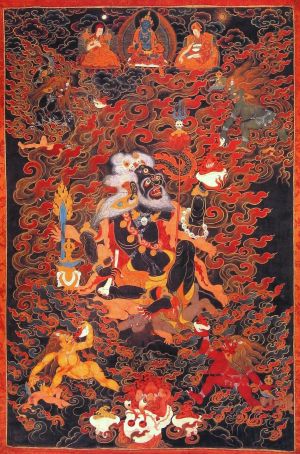Conceptual and Non-conceptual Mental States in the Yogācāra Tradition
by Jowita Kramer
“concept” (vikalpa) <> “non-conceptual(ity)” (nirvikalpa)non-conceptual awareness (nirvikalpajnana) true awareness (samyagjnana) mind (citta) and mental factors (caitasika) imprints (vasana) stored in the “store mind” (alayavijhana) imprints of
• all sense perceptions (vijhana)
• mental perception (manovijhana)
• concept of I (klistamanas)
• all emotions, such as hatred, anger, jealousy (and all the other samskaras) imprints of
• “everyday usage of phenomena, names and conceptions” (nimitta- nama-vikalpa-vyavahara-prapahca)
• “sticking to the imagined nature [of reality]” (parikalpitasvabhavabhinivesa) • duality of the grasper and the grasped (grahadvayavasana) • concepts of one's own self (atmadivikalpa) and • concepts of entities, such as matter (rupadidharmavikalpa) concepts of • the nature [of a phenomenon] (svabhavavikalpa) • its characteristics (visesavikalpa), • wholes (pindagrahavikalpa)
these first three give rise to "things" (vastu) which themselves become the basis for vikalpa and proliferation • "I" (aham iti vikalpah)
• "mine" (mameti vikalpah)
• pleasant (priyavikalpa)
• opposite of both (tadubhayaviparitavikalpa)“mental representation only” (vijhaptimatra) from imprint of language
from imprint of “the wrong view of the self”
Mental representation (vijhapti) of
• body (= five sense faculties)
• the one who possesses the body (= klistamanas)
• experiencer (bhoktr; manodhatu)
• that which is experienced by him (= six objects)
• experiencing with regard to this (= six vijhanas)
• time
• numbers • abode (= surrounding world,bhajanaloka)
• conventional speech (vyavahara)
• distinction between oneself and others _[[usmagata mu rd han ksanti
seeing all factors as "mental representation only"
1. no object
2. no subject
1st stage (bhumi) path of seeing (darsanamarga) » non-conceptual awareness (nirvikalpajhana) 2nd to 10th stagemind (citta) in the sense of true awareness (samyagjnana) or neither citta nor acitta
• pure realm (anasravah dhatuh)
• liberation (mukti)
• abiding in the realm of the mind (cittasyadhatau sthanam)
• realm without proliferation (nisprapancadhatu)
• “suchness” (tathata) of all phenomena
• = non-differentiated truth preparatory stage
usmagata mu rd han ksanti laukikagradharma 1st stage (bhumi) path of seeing (darsanamarga) 2nd to 10th stage. no object
2. no subject
» nirvikalpajnanapreparatory stage
usmagata mu rd han ksanti laukikagradharma 1st stage (bhumi) path of seeing (darsanamarga) 2nd to 10th stage1. no object
2. no subject
"non-differentiated"
(avyavasthapita) usmagata murdhan ksanti
seeing all factors as "mental representation only"
1. no object
2. no subject
1st stage (bhumi) path of seeing (dars'anomargo) » nirvikalpajhana
"non-differentiated"
2nd to 10th stage path of cultivating (bhavanamarga)
"differentiated"
5 sense perceptions klistamanas> mirror-like awareness (adarsajnana)
= non-conceptual awareness (nirvikalpajndna)
> awareness of differentiation (pratyaveksajnana)
> awareness of accomplishment of deeds
(krtydnusthdnajndna) > awareness of equality (samatajnana) feelings (vedana) >> mastery of the pleasant abodes (sukhavihara) apperception (samjha) >> mastery of teaching by means of words (naman), phrases (pada) and syllables (vyahjana)
